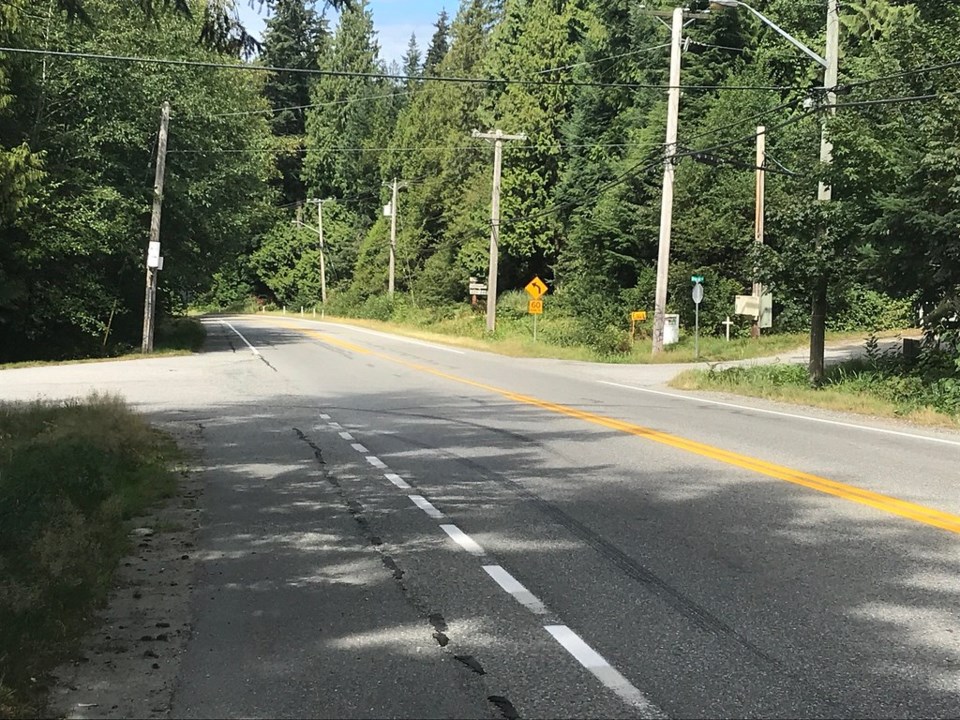The province will start work next summer on one of the projects recommended in the Highway 101 corridor study – improvements to the Joe Road/Orange Road intersection – but the study also recommends more than $20 million in other potential safety improvements.
Many of the proposals are similar to recommendations in the Sunshine Coast Regional District’s 2011 Integrated Transportation Study, including major work in Davis Bay and Selma Park.
The consultants, Parsons Corporation, say current conditions on that segment of Highway 101 “result in delays for through-traffic passing through the area, frequent conflicts with turning vehicles, and an unprotected environment for pedestrians.”
The intersections at Field Road (six collisions from 2013-17), Davis Bay Road (seven collisions), Bay Road (nine collisions), and Selma Park Road (12 collisions) are singled out as “collision hotspots.”
The proposed solutions include adding left-turn lanes, turning restrictions at several intersections, wider shoulders and sidewalks and a new traffic signal and crosswalk at Davis Bay Road.
At Highway 101 at Ti’Ta Way, the road leading to Sechelt Hospital and the Tsain-Ko Village Shopping Centre where some 10 collisions occurred from 2013-17, the study suggests changes to restrict left-turns off the highway.
The estimated capital cost for all the proposed changes in the Davis Bay-Selma Park area is $11 million.
At Flume Road and 101 in Roberts Creek, where there were seven collisions recorded from 2013-17, the consultants recommended making Flume “right in/right out” and shifting traffic needing to turn north onto the highway to Marlene Road. The study also recommends left-turn lanes on 101 southbound at Lockyer Road and northbound at Marlene. The capital cost is estimated at $2.8 million.
The study recommends a southbound left-turn lane and a southbound deceleration lane at Highway 101 and Lower Road/Highland Road. The estimated capital cost of those improvements is $925,000.
At Sechelt’s main intersection, where Highway 101 meets Wharf Avenue and Dolphin Street, the study recommends changes to the signal timing and lane configurations, at an estimated capital cost of $250,000.
The consultants recommend upgrading the intersection of Highway 101 and Shorncliffe Avenue to a full signal and making “geometry refinements,” at an estimated capital cost of $1.7 million. That intersection recorded six collisions between 2013 and 2017.
The south end of Redrooffs Road and Highway 101 was also identified as having a collision rate above the provincial average and the study recommends Redrooffs immediately south of the highway be realigned to intersect 101 at 90 degrees, at an estimated capital cost of $725,000. The province would also need to acquire “a small area of the undeveloped property.”
The province would also have to acquire private land to complete recommended improvements at the 101-Hill Road intersection, which saw seven collisions. “It is proposed that the Hill Road intersection is closed, and a new intersection formed further north along Highway 101 through an extension of Dale Road,” the consultants said. The capital cost is estimated at $2.7 million.
There were no recommendations on improvements for four other intersections with high collision frequencies identified in the study: Highway 101 and Largo Road (seven collisions); Neilson Road (six collisions); Field Road; and Norwest Bay Road (six collisions).
The corridor study also offers three options for adding passing lanes in the Roberts Creek area, one southbound between Leek Road and Highland Road and two northbound between Leek Road and Maskell Road and between Pell Road and Jack Road, with estimated capital costs of $5.1 to $7.6 million.



